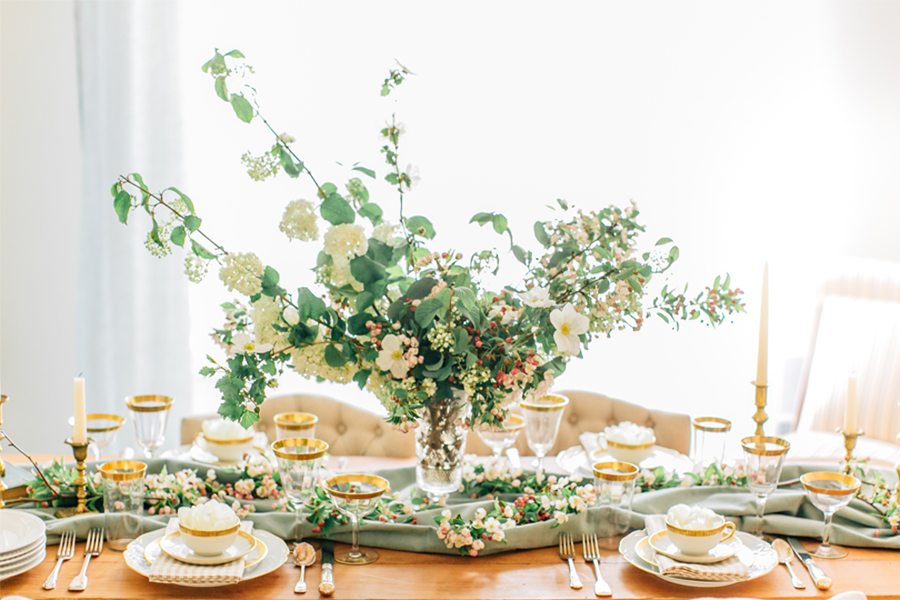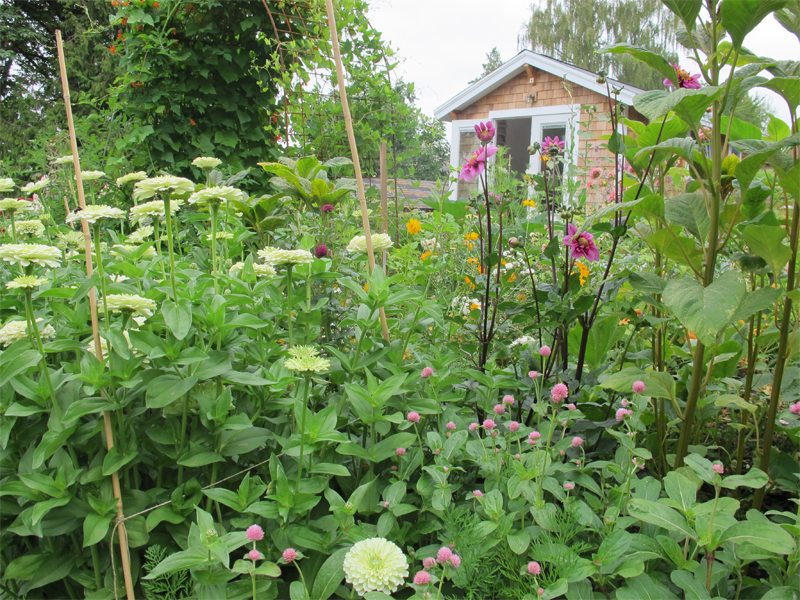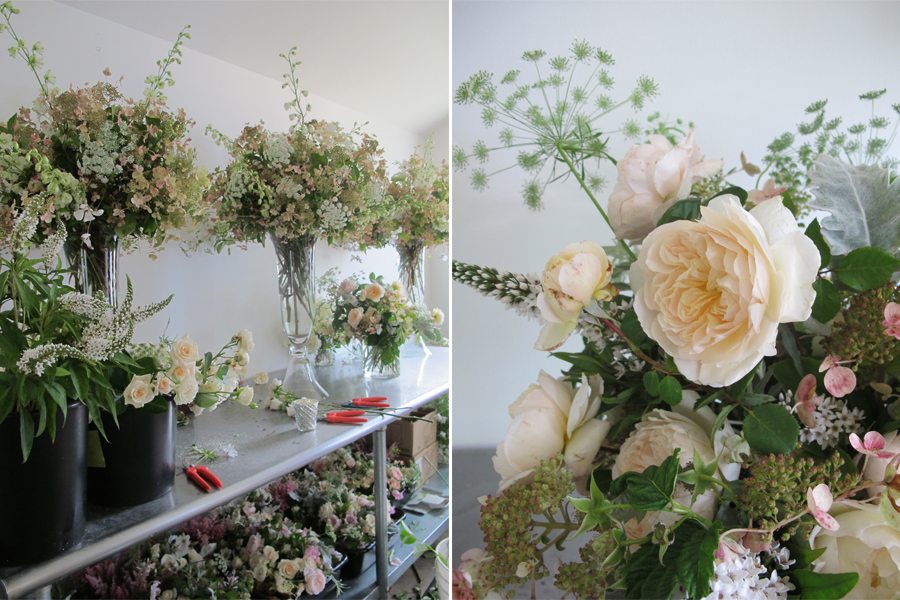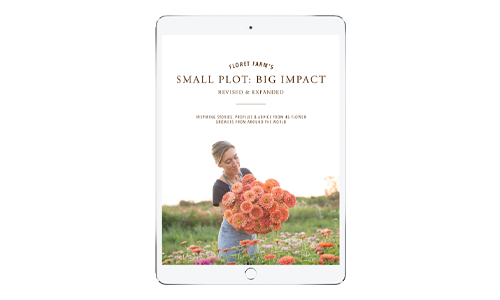 For this week’s installment of the {Farmer & the Florist} I have the pleasure of chatting with the uber-talented Kelly Sullivan, owner of Botanique design studio based in Seattle. Kelly was featured in the New York Times’ “Farm to Centerpiece” story earlier this year which detailed her dedication to sourcing local, seasonal flowers for a wintery February wedding!
For this week’s installment of the {Farmer & the Florist} I have the pleasure of chatting with the uber-talented Kelly Sullivan, owner of Botanique design studio based in Seattle. Kelly was featured in the New York Times’ “Farm to Centerpiece” story earlier this year which detailed her dedication to sourcing local, seasonal flowers for a wintery February wedding!
Kelly and I both share a love of lush, garden- inspired bouquets. Our designs recently graced the pages of Seattle Met Bride & Groom magazine. The “Lush Life” shoot at the gorgeous Dunn Gardens featured ultra-elegant gowns with subtle floral accents paired with our opulent bouquets of seasonal Seattle-area blooms. I asked Kelly to chat briefly about her work, seasonal flowers and the cutting garden in South Seattle where she grows some of the flowers and foliage used in her event designs.
 Erin: Thanks so much for taking time to talk with me today, Kelly! I’ve enjoyed following your blog these last few months—you have such a great eye for texture and color in your designs! I have also noticed you have been designing a lot of cascading bouquets this year- which is a trend I *definitely* hope to see more of! What are some of your favorite flowers, vines and foliage you use to create this romantic and dramatic draping look?
Erin: Thanks so much for taking time to talk with me today, Kelly! I’ve enjoyed following your blog these last few months—you have such a great eye for texture and color in your designs! I have also noticed you have been designing a lot of cascading bouquets this year- which is a trend I *definitely* hope to see more of! What are some of your favorite flowers, vines and foliage you use to create this romantic and dramatic draping look?
Kelly: Thanks so much for asking me to participate in this wonderful series, Erin! Yes, cascading bouquets have been big for us this year, and I can’t say I object- I love the romance and beauty of their draping form. Some of my favorite materials to create this shape are, of course, vines! I especially love clematis, and Sweet Autumn clematis in particular. It has more delicate flowers than many other varieties, and even when it’s not blooming has really elegant foliage. I have also been using a lot of nasturtium vines this year. I worked with one couple that wanted lots of edibles in their designs, so for that bouquet I used scarlet runner beans/vines and cherry tomatoes (Matt’s wild cherry tomato, to be specific). Fruiting branches can be great too- often the weight of their fruit makes them trail in just the right way.
 Erin: I absolutely love the fact you are sourcing a lot of your floral ingredients from your own cutting garden in Seattle. Tell me more about your growing season. What were some of your favorite varieties you grew?
Erin: I absolutely love the fact you are sourcing a lot of your floral ingredients from your own cutting garden in Seattle. Tell me more about your growing season. What were some of your favorite varieties you grew?
Kelly: Yes, we are so fortunate to have some space in the city devoted to growing flowers. Our growing season typically starts in February/March, with early spring bulbs like narcissus and fritillaria, as well as hellebores, and some overwintered dusty miller and cerinthe if we are lucky with a mild winter! Things typically continue to grow through late October, though this year we were still picking into November. The most abundant time is late June-September, as we grow a lot of annuals, garden roses and dahlias, all with their heyday over the summer.
Some of my favorites this year were orlaya, digitalis (esp. ‘Dalmation Peach’), Quickfire and Taradiva hydrangea, and a new dahlia variety for me called ‘Mystique.’ I also had a pretty serious love affair with Koko Loko roses and variegated dogwood foliage. Having some of the wedding design standbys out there was also quite wonderful- garden roses, tree peonies, and dahlias all look so much more radiant when they are fresh cut, and the length of their journey from garden to arrangement is literally about 20 feet! And sanguisorba! We have a variegated variety that blooms really late in the season that I love.
 Erin: Like most gardeners, you’re probably already planning for next year, even though it isn’t even Christmas yet. What are some of the floral varieties that will get primo real estate in your garden next season?
Erin: Like most gardeners, you’re probably already planning for next year, even though it isn’t even Christmas yet. What are some of the floral varieties that will get primo real estate in your garden next season?
Kelly: I really love small flowers, and those with multiple blooms branching off in different directions. So we will be planting both rose and white varieties of gomphrena next year, as well as some pastel varieties of clarkia, lots of foxglove, and Iceland poppies. Our Japanese anemones are really getting going, which I am super excited about. We’re keeping (and probably expanding) a rather large row of Café au lait dahlias as they are so, so popular- I think we used just about every stem of those that we grew this year! We will be adding more garden roses (Jude the Obscure and Hot Cocoa for sure), as well as expanding one area to plant more shrub foliages. I can never get enough mock orange, so that will definitely be in the mix. I was given a lot of lily of the valley last spring, and am excited for that to bloom next year. Right now I am really happy that we just got all our spring bulbs planted. ‘Charming Beauty’ is one of my favorite tulips, and I can’t wait until it starts blooming! Plus fritillaries, I love, love, love fritillaries, and we have white, checkered plum and a brownish/green variety in the ground for next spring.
 As we have very limited space (just a regular, city backyard) it is a challenge to maximize our small growing area. By nature I want to try everything, and have lots of favorites, so I find it hard to limit myself to a “smart” selection of flowers that I know I will be able to use. That means that there are always crops that just don’t line up with the events we have color-wise, or don’t work out how I had hoped. But while I know we would use an entire garden full of raspberry foliage and café au laits, that would be so boring! So I tend to plant a pretty diverse array of flowers in smaller numbers, which is way more fun, and gives us a pretty great palette to choose from. My husband Eli also makes sure we get a lot of vegetables in the ground, and though I always think I want every square inch devoted to flowers, the minute the first tomato ripens, I do a serious happy dance! As the years go by, I am excited to develop more perennial and shrub areas- we really focused on annuals to get things going when we first moved here, but I am looking forward to getting more foliages and flowering branches into the mix.
As we have very limited space (just a regular, city backyard) it is a challenge to maximize our small growing area. By nature I want to try everything, and have lots of favorites, so I find it hard to limit myself to a “smart” selection of flowers that I know I will be able to use. That means that there are always crops that just don’t line up with the events we have color-wise, or don’t work out how I had hoped. But while I know we would use an entire garden full of raspberry foliage and café au laits, that would be so boring! So I tend to plant a pretty diverse array of flowers in smaller numbers, which is way more fun, and gives us a pretty great palette to choose from. My husband Eli also makes sure we get a lot of vegetables in the ground, and though I always think I want every square inch devoted to flowers, the minute the first tomato ripens, I do a serious happy dance! As the years go by, I am excited to develop more perennial and shrub areas- we really focused on annuals to get things going when we first moved here, but I am looking forward to getting more foliages and flowering branches into the mix.
 Erin: You offer consulting services to design and install cutting gardens, isn’t that right? Are you seeing increased interest among fellow floral designers or is there a separate subset of gardeners and creatives seeking cutting gardens?
Erin: You offer consulting services to design and install cutting gardens, isn’t that right? Are you seeing increased interest among fellow floral designers or is there a separate subset of gardeners and creatives seeking cutting gardens?
Kelly: I do see interest among fellow floral designers, but the majority of my cutting garden clients are home gardeners who have a particular fondness for flowers, or people who just love to arrange for fun. Most of the floral designers I know in Seattle either have a garden of some sort already, or are starting to experiment with growing some of their favorites. I do field questions from floral design friends about their gardens, but in a much less formal way than with most of my cutting garden clients.
 Erin: What words of encouragement or advice do you have for floral designers considering creating their own cutting gardens to use in design work?
Erin: What words of encouragement or advice do you have for floral designers considering creating their own cutting gardens to use in design work?
Kelly: A great place to start is with what you already have- when we bought our house, the only plants on the property were a GIANT laurel hedge, one badly-shaped juniper, and a ton of ivy. I thought I hated ivy…. until I used it to make my favorite wedding arch of all time! Sometimes the thing that makes the design pop is way more obvious than you might think, and literally right in front of your nose without any work at all. So take stock of what you already have and consider how you might use it.
 As for getting started with a more intentional cutting garden, I say just get started, no matter how small-scale! It could literally be a few pots. Starting with an area that you can realistically take care of, that isn’t completely overwhelming, is important. You can always add more. What I think typically dissuades people from gardening is becoming overwhelmed with the work involved, because (as you well know) it is a lot of work! Especially for floral designers, because we are so busy with weddings during the main growing season, it can be hard to keep a large cutting garden going strong. So start small, and don’t be discouraged if something doesn’t work out. Your garden may turn into a wild jungle that you can barely walk through- mine always does, and that is what yields those gorgeous, twisting, turning stems that create such beautiful movement in arrangements! So often the “mistakes” end up being the best parts of the garden- they create something unexpected.
As for getting started with a more intentional cutting garden, I say just get started, no matter how small-scale! It could literally be a few pots. Starting with an area that you can realistically take care of, that isn’t completely overwhelming, is important. You can always add more. What I think typically dissuades people from gardening is becoming overwhelmed with the work involved, because (as you well know) it is a lot of work! Especially for floral designers, because we are so busy with weddings during the main growing season, it can be hard to keep a large cutting garden going strong. So start small, and don’t be discouraged if something doesn’t work out. Your garden may turn into a wild jungle that you can barely walk through- mine always does, and that is what yields those gorgeous, twisting, turning stems that create such beautiful movement in arrangements! So often the “mistakes” end up being the best parts of the garden- they create something unexpected.

Erin: Finally, I’m curious to learn more about your perspectives on the local, seasonal floral design trends. Where do you see it going—and growing—in the future?
Kelly: Working mostly in weddings, I see people wanting beauty, magic, love, luminescence, even a sense of spiritual connection from their flowers. My clients tend to have a general sense/excitement about local flowers, but ultimately they want the magic and beauty, they want something that creates an elevated experience. If you ask me, the BEST way to get this is with those exquisite, glowing, local flowers! In my experience, choosing local flowers for my clients always makes them happy, makes them engage more with their flowers- they notice things like the fragrance, or the delicacy of a bloom, or some unique element that they have never seen before…. And this makes them have an interaction with their flowers, which makes them more curious about their flowers, which hopefully makes them just a little more conscious about their flower choices down the line. As floral designers, we have a lot of power to choose where the flowers we use come from, and I think the more clients experience local the more they want local- all politics aside, there is just a real, qualitative difference.
 With the current trend towards looser, free-form bouquets and non-traditional floral elements in arrangements, I think there is a lot of opportunity to embrace a local, in-season aesthetic. But even as trends evolve and change, I think people will still want many of the same things from their flowers, as they are relatively timeless- that beauty, elegance and magical, “of-the-moment” quality that makes something really resonate with its surroundings. If you want that magic, then you probably want something different in the summer versus the winter- they are really different times of year! What looks at home in each respective season- what smells the best, and has the strongest impact- that is constantly evolving.
With the current trend towards looser, free-form bouquets and non-traditional floral elements in arrangements, I think there is a lot of opportunity to embrace a local, in-season aesthetic. But even as trends evolve and change, I think people will still want many of the same things from their flowers, as they are relatively timeless- that beauty, elegance and magical, “of-the-moment” quality that makes something really resonate with its surroundings. If you want that magic, then you probably want something different in the summer versus the winter- they are really different times of year! What looks at home in each respective season- what smells the best, and has the strongest impact- that is constantly evolving.
 Erin: Kelly, THANK YOU so much for your time today and thank you for your continued commitment and advocacy for local, seasonal flowers. I hope our paths cross again soon!
Erin: Kelly, THANK YOU so much for your time today and thank you for your continued commitment and advocacy for local, seasonal flowers. I hope our paths cross again soon!
Kelly: Me too Erin! Thanks so much for all that you do to advocate for and inspire people all over the world to seek out local flowers, and grow their own! You have been a huge inspiration to me all along, as well as a generous resource, and I know many, many others feel the same.
Connect with Botanique:
photos by (top to bottom): Barbara Kinny, Michelle M. Waite, Kirk Mastin, Lora Grady, Kelly Sullvian (3), Lora Grady, Kelly Sullivan, Jess Hunter Photography (2)







Announcing the Floret Workshop Scholarship Winners - Floret Flowers on
[…] Jenn started planning and planting away in her home’s small yard after being inspired by my interview with Kelly Sullivan and her mini city garden. She seeks to, as she describes, “create honest and natural […]